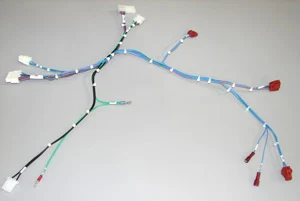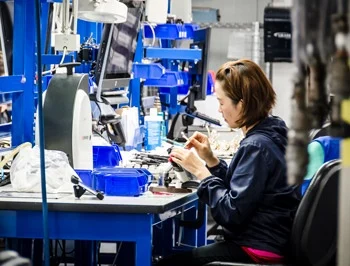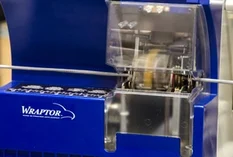The wire harness manufacturing process is time consuming, difficult, and task oriented. Nonetheless, as the demand for wire harnesses and cable assemblies grow, manufacturing of these components continues to expand. That’s because the wire harness is one of the most indispensable electronic and electrical components in the modern world!
Step 1: Design
 Whether hidden behind a glove box in an automobile or within the back panel of a washing machine, the wire harness delivers power and transmits information in a streamlined, uniform way. In electronic product research and development, engineers must confront and overcome electrical issues daily to successfully bring a product to market. An integral part of this challenge entails a custom design for each products electronic part and a step by step wire harness manufacturing process to complete the assembly. This is also the stage at which engineers must choose harness components and decide on other use specifications.
Whether hidden behind a glove box in an automobile or within the back panel of a washing machine, the wire harness delivers power and transmits information in a streamlined, uniform way. In electronic product research and development, engineers must confront and overcome electrical issues daily to successfully bring a product to market. An integral part of this challenge entails a custom design for each products electronic part and a step by step wire harness manufacturing process to complete the assembly. This is also the stage at which engineers must choose harness components and decide on other use specifications.
Step 2: Prototyping
If necessary, wire harness prototyping enables an engineer or product designer to get their hands on a real-life version of their final product. They can then test the harness in its intended application before beginning the first production run, ensuring optimal performance.
Step 3: Production & Assembly
 In wire harness manufacturing, design specifications must be met and high quality standards with minimal error rates must be maintained. Remarkably, in this day and age, as automated manufacturing expands globally in nearly every sector, wire harness manufacturing processes still rely in no small part on manual assembly. Though some automation can be incorporated into the process, hand manufacturing of wire harnesses and cable assemblies are necessary due to the many intricate and time consuming steps involved in completing the process. Even though building a wire harness can be difficult and task oriented, manual production remains more cost effective.
In wire harness manufacturing, design specifications must be met and high quality standards with minimal error rates must be maintained. Remarkably, in this day and age, as automated manufacturing expands globally in nearly every sector, wire harness manufacturing processes still rely in no small part on manual assembly. Though some automation can be incorporated into the process, hand manufacturing of wire harnesses and cable assemblies are necessary due to the many intricate and time consuming steps involved in completing the process. Even though building a wire harness can be difficult and task oriented, manual production remains more cost effective.
Another reason manual production remains the primary method of manufacturing for wire harnesses and cable assemblies is that each must be customized for each application. Wire harnesses are very specific components designed for specific larger parts. They are necessitated to resolve geometric and electrical issues in manufacturing products and to provide solutions to particular problems inherent in the overall process. Geometrically, wire harnesses are designed to fit a specific space within a much larger or alongside a greater network of electrical components and wiring. Wire harnesses also must ground and protect wires from potential internal and external damages related to electrical issues such as crossed wires, chemicals or moisture.
Wire Cutting
Broadly speaking, the initial step in building a wire harness is make sure the wires are cut to the right length, which is done by a wire-cutting machine.
Stripping & Connections
The next step requires that the wire ends must be stripped for the cores to be exposed. This is done to attach terminals or connector housings or modules next.
Assembly
Lastly, the wires are gathered into a harness utilizing a workbench or assembly board to meet the design specifications.
Hand manufacturing of wire harness production is necessary to route wires through sleeves and to apply fabric tape where needed, such as on branch outs from wire strands. Terminals need to be crimped onto wires, and where more than one wire needs to be attached to one terminal, multiple crimping will be necessary. Also, the insertion of one sleeve into another is done manually, and so is fastening any strands with tape, clamps or cable ties.
 Hand production does not exclude the use of automation and machinery in wire harness manufacturing. Cutting machines are used to uniformly cut wires to specified lengths, machines are used to crimp terminals or to partially plug wires with fitted terminals into connector modules. Solder machines are necessary for sealing wire ends as are tools to twist the wire.
Hand production does not exclude the use of automation and machinery in wire harness manufacturing. Cutting machines are used to uniformly cut wires to specified lengths, machines are used to crimp terminals or to partially plug wires with fitted terminals into connector modules. Solder machines are necessary for sealing wire ends as are tools to twist the wire.
Step 4: Testing
Once production is complete, each individual wire harness must undergo electrical safety testing for any specifications it may be subject to in real-world operation. This step is crucial in ensuring the final product performs 100% reliably.
Wire harness manufacturing is a process. Design and assembly from the drawing board to finished wire harness requires step by step planning and a good amount of manual production. Each wire harness has a specific purpose to integrate into a larger electronic network, which, in the modern world, truly does make wire harnesses indispensable.
JEM Electronics is a trusted leader in custom cable assemblies and wire harnesses, serving customers in a wide variety of industries for over 30 years. If you have a need for custom assemblies or harnesses, contact the experts at JEM today!


